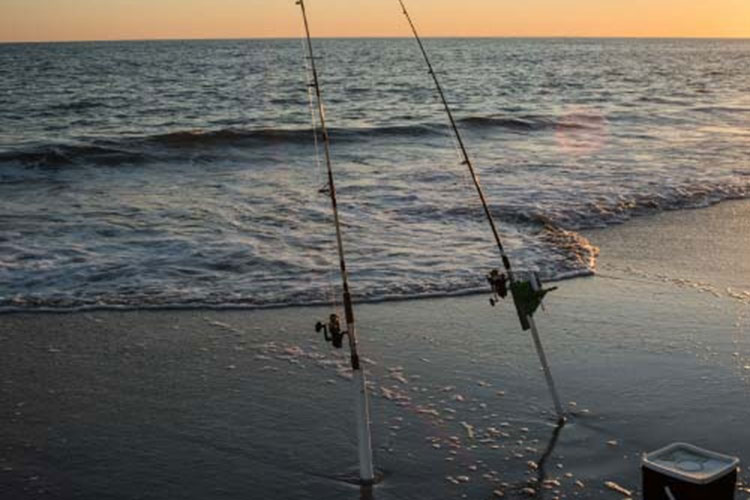To use a fish finder to catch fish, study the manual for instructions on operating the device correctly. Then, identify areas in the water where fish are likely to be present, such as drop-offs or underwater structures, and use the fish finder to locate them.
What Is A Fish Finder And How Does It Work?
A fish finder is a device that helps anglers locate fish underwater using sonar technology. It works by sending out sound waves, which bounce off objects in the water, including fish, creating a visual representation on a screen. The device consists of a transducer, which is mounted on the boat and sends and receives the sound waves, and a display unit that shows the fish and the underwater landscape.
Fish finders use basic principles of fish finding technology to determine the depth, temperature, and structural features of the water. The transducer converts the sound waves into electrical signals, which are then transmitted to the display unit for interpretation. With the help of a fish finder, anglers can identify fish, their size, and even their behavior, improving their chances of a successful fishing trip.
Selecting The Right Fish Finder For Your Needs
Selecting the right fish finder for your needs involves considering several factors, such as your fishing style, budget, and fishing environment. Additionally, understanding the different types of fish finders available in the market is crucial. There are portable fish finders, fixed mount fish finders, and castable fish finders, each with its own advantages and disadvantages.
Moreover, it is essential to grasp the features and specifications of a fish finder before making a purchase. Some key features to look for include screen resolution, frequency of sonar waves, and GPS capabilities. By carefully evaluating these factors and understanding the options available, you can choose a fish finder that will be effective in helping you catch more fish.
Mastering The Art Of Using A Fish Finder
Mastering the art of using a fish finder involves mounting and installing the device properly. Adjusting the settings is crucial to ensure optimal performance. Interpreting the display is essential as it helps in locating fish hotspots. By following these steps, you can effectively utilize a fish finder to catch fish.

Credit: inthespread.com
Choosing The Correct Transducer And Understanding Its Importance
When it comes to using a fish finder, choosing the correct transducer is of utmost importance. Understanding its applications and types is essential. Installing and maintaining the transducer correctly is crucial for optimal performance. Factors to consider when purchasing a transducer include its compatibility with your fish finder unit.
The frequency and cone angle should also be taken into account to ensure accurate and detailed readings. Additionally, the depth capabilities and power output are vital factors to consider. By selecting the right transducer, you can enhance your fishing experience by accurately locating and catching fish.
Don’t overlook the significance of the transducer in maximizing the effectiveness of your fish finder.
Starting Your Fishing Expedition: Finding The Best Spots
Researching fishing locations and techniques is essential for a successful fishing expedition. Using a fish finder can greatly enhance your chances of finding the best spots. By utilizing a fish finder, you can easily identify underwater structures and other features that attract fish.
The data provided by the fish finder can also help you locate areas with high fish activity and feeding patterns. This valuable information allows you to strategize your fishing approach and improve your chances of catching fish. So, if you want to take your fishing skills to the next level, make sure to incorporate the use of a fish finder into your fishing expeditions.
Unlocking The Advanced Features Of Your Fish Finder
Unlocking the advanced features of your fish finder involves integrating GPS and navigation functionalities. By utilizing the built-in GPS, you can pinpoint the exact location of potential fishing spots, ensuring higher chances of a successful catch. Additionally, these navigation features enable you to navigate through unfamiliar waters with ease, avoiding obstacles and locating hotspots.
Understanding and utilizing fish finder mapping capabilities further enhances your fishing experience. By customizing settings tailored to specific fishing conditions, you can optimize the performance of your fish finder. Adjusting settings such as sensitivity, depth range, and frequency ensures accurate readings and better target identification.
By maximizing the advanced features of your fish finder, you can greatly improve your fishing success and make the most of your fishing trips.
Maximizing Your Fishing Success: Tips And Tricks
Maximizing your fishing success starts with effectively using a fish finder in different scenarios. Adjust sensitivity settings to get accurate readings. Interpret the underwater data to locate fish. But don’t rely solely on the fish finder. Use other tools and techniques to increase your chances of catching fish.
Experiment with different bait, tackle, and fishing styles. Know the best spots to cast your line. Pay attention to weather conditions and water temperature. By combining the fish finder with other strategies, you can enhance your fishing skills and improve your chances of reeling in a big catch.
Troubleshooting Common Fish Finder Issues
Fish finders are handy tools for anglers to locate fish in bodies of water. However, like any electronic device, fish finders can encounter issues. Identifying and fixing common problems can ensure optimal performance. Regular maintenance and care are crucial to keep your fish finder in top condition.
This includes cleaning the screen and transducer, checking the battery, and inspecting the wiring for any damages. If you encounter persistent issues or are unsure about troubleshooting, seeking professional help is recommended. A qualified technician can diagnose and address more complex problems.
By following these guidelines for troubleshooting and maintenance, you can make the most of your fish finder and enhance your fishing experience.
Stay Ahead Of The Game: Keeping Up With Fish Finder Innovations
Keeping up with the latest trends and advancements in fish finder technology is essential for staying ahead of the game. By staying updated with new features and models, you can maximize your fishing experience. Future developments and potential improvements in fish finders promise even more accurate and efficient ways of locating fish.
With each innovation, the benefits are undeniable. Improved display resolutions and screen technologies allow for clearer and more detailed views. Enhanced sonar capabilities provide precise readings of the underwater environment, identifying fish species and their precise locations. Advanced GPS integration enables better navigation and mapping, allowing you to cover more fishing spots and increase your chances of success.
As technology continues to evolve, staying informed and open to new features ensures fishermen can make the most out of their fishing trips. So, take advantage of fish finder advancements and watch your fishing game soar.
Frequently Asked Questions For How To Use Fish Finder To Catch Fish
How Does A Fish Finder Work?
A fish finder uses sonar technology to send sound waves into the water and detect objects, including fish. The sound waves bounce off the fish and other underwater structures, and the fish finder interprets the returning signals to display the location, size, and depth of the fish.
Can I Use A Fish Finder In Any Type Of Water?
Yes, fish finders can be used in a variety of bodies of water, including lakes, rivers, and oceans. However, the effectiveness of the fish finder may vary depending on factors such as water depth, clarity, and the presence of underwater obstructions.
How Can A Fish Finder Help Me Catch More Fish?
A fish finder can significantly improve your fishing success by providing valuable information about the underwater environment. It allows you to locate schools of fish, determine their depth and size, and identify underwater structures where fish may be hiding. This can help you make more informed decisions and increase your chances of catching fish.
Conclusion
To wrap up, utilizing a fish finder can drastically enhance your fishing experience. This state-of-the-art tool allows you to locate fish more efficiently, increasing your chances of a successful catch. By understanding the key features, such as sonar technology and GPS mapping, you can effectively use your fish finder to locate fish in various water depths and structures.
Additionally, optimizing your settings and interpreting the data displayed on your fish finder’s screen will enable you to identify fish and distinguish them from underwater debris or vegetation. Remember to keep an open mind and always be willing to experiment with different techniques and strategies.
With practice, patience, and a well-equipped fish finder, you can take your fishing game to new levels. Start harnessing the power of this valuable tool and watch your fishing prowess soar. Happy fishing!





